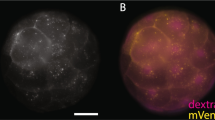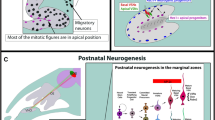Summary
All cells in the optic vesicle of Xenopus embryos from stages 27 to 31 have the same ultrastructure. They are elongated and appear to extend from the internal to the external surfaces of the optic vesicle. They are bound together by terminal bars at the internal (lumen) margin, have microvilli and a cilium on the internal margin, and are covered with a basement membrane on the external margin. Their cytoplasm contains abundant free ribosomes, polysomes, mitochondria, yolk and lipid inclusions, and sparse endoplasmic reticulum.
Although other studies have shown that retinal ganglion cells originate at stages 29–30 and have their central connections determined before stage 31, these events could not be correlated with any ultrastructural changes. The first sign of differentiation in retinal cells was an increase in endoplasmic reticulum and Golgi apparatus at stage 32. Microtubules and microfilaments appeared at stage 33 in association with the first axonal outgrowth from retinal ganglion cells. Cytodifferentiation proceeded gradually until large areas of Nissl substance had developed by stage 35. At larval stage 48 the ganglion cells resembled those in the adult.
Similar content being viewed by others
References
Behnke, O.: Cytoplasmic microtubules in vertebrate cells. J. Ultrastruct. Res. 12, 241 (1965).
Bellairs, R.: The development of the nervous system in chick embryos, studied by electron microscopy. J. Embryol. exp. Morph. 7, 94–115 (1959).
Del Cerro, M. P., Snider, R. S., Oster, M. L.: Evolution of the extracellular space in immature neurons. Bxperientia (Basel) 24, 929–930 (1968).
Dowling, J.: Synaptic organization of the frog retina: An electron microscopic analysis comparing the retinas of frogs and primates. Proc. roy. Soc. B 170, 205–228 (1968).
Droz, B.: Protein metabolism in nerve cells. Int. Rev. Cytol. 25, 363–390 (1969).
Eschner, J., Glees, P.: Free and membrane-bound ribosomes in maturing neurons of the chick and their possible functional significance. Experientia (Basel) 19, 301–303 (1963).
Freed, J. J., Bhisey, A. N., Lebowitz, M. M.: The relation of microtubules and microfilaments to the motility of cultured cells. J. Cell Biol. 39, 46–47a (1968).
Fujita, H., Fujita, S.: Electron microscopic studies on neuroblast differentiation in the central nervous system of the domestic fowl. Z. Zellforsch. 60, 433–478 (1963).
Fujita, S.: The matrix cell and cytogenesis of the developing CNS. J. comp. Neurol. 120, 37–42 (1963).
—: Application of light and electron microscopy autoradiography to the study of cytogenesis of the forebrain. In: Evolution of the forebrain, edit. by R. Hassler and H. Stephan. New York: Plenum Press 1966.
Gaze, R. M., Peters, A.: The development, structure, and composition of the optic nerve of Xenopus laevis au (Daudin). Quart. J. exp. Physiol. 46, 299–309 (1961).
Herman, L., Kauffman, S. L.: The fine structure of the embryonic mouse neural tube with special reference to cytoplasmic microtubules. Develop. Biol. 13, 145–162 (1961).
Jacobson, M.: Retinal ganglion cells: Specification of central connection in larval Xenopus laevis. Science 155, 1106–1108 (1967).
—: Cessation of DNA synthesis in retinal ganglion cells correlated with the time of specification of their central connections. Develop. Biol. 17, 219–232 (1968a).
—: Development of neuronal specificity in retinal ganglion cells of Xenopus. Develop. Biol. 17, 202–218 (1968b).
Karlsson, U.: Observations on the postnatal development of neuronal structures in the lateral geniculate nucleus of the rat by electron microscopy. J. Ultrastruct. Res. 17, 158–175 (1967).
Lyser, K.: Early differentiation of motor neuroblasts in the chick embryo as studied by electron microscopy. II. Microtubules and neurofilaments. Develop. Biol. 17, 117–142 (1968).
Meller, K., Glees, P.: Early differentiation in the cerebral hemisphere of mice. An electron microscopical study. Z. Zellforsch. 72, 525–533 (1966).
Millonig, G.: A modified procedure for lead staining of thin sections. J. biophys. biochem. Cytol. 11, 736–739 (1961).
Mugnaini, E., Forströnen, P. F.: Ultrastructural studies on cerebellar histogenesis. I. Differentiation of granule cells and development of glomeruli in the chick embryo. Z. Zellforsch. 77, 115–143 (1967).
Nagai, R., Rebhun, L. I.: Cytoplasmic microfilaments in streaming Nitella cells. J. Ultrastruct. Res. 14, 571–589 (1966).
Meuwkoop, P. D., Faber, J.: Normal tables of Xenopus laevis (Daudin). Amsterdam: North Holland Press 1956.
Porter, K. R.: The ground substance; observations from electron microscopy. In: The cell. vol. II, edit. by J. Brachet and A. Mirsky. New York: Academic Press 1961.
Ramón y Cajal, S.: Studies on vertebrate neurogenesis. 1929. Translated into English by L. Guth. Springfield (Ill.): Ch. C. Thomas 1959.
Reynolds, E. S.: The use of lead citrate at high pH as an electron opaque stain in electron microscopy. J. Cell Biol. 17, 208–212 (1963).
Sechrist, J. W.: Neurocytogenesis. I. Neurofibrils, neurofilaments, and the terminal mitotic cycle. Amer. J. Anat. 124, 117–134 (1969).
Slautterback, D. B.: Cytoplasmic microtubules. I. Hydra. J. Cell Biol. 18, 367–388 (1963).
Taylor, A. C.: The centriole and microtubules. Amer. Naturalist 99, 267–278 (1965).
Tennyson, V. M.: Electron microscopic study of the developing neuroblast of the dorsal root ganglion of the rabbit embryo. J. comp. Neurol. 124, 267–318 (1965).
Wechsler, W.: Electron microscopy of the differentiation in the developing brain of the chick embryo. In: Evolution of the forebrain. Edit. by R. Hassler and H. Stephan. New York: Plenum Press 1966.
—, Meller, K.: Electron microscopy of neuronal and glial differentiation in the developing brain of the chick. Progr. Brain Res. 26, 93–144 (1967).
Wohlman, A., Allen, R. D.: Structural organization associated with pseudopod extension and contraction during cell locomotion in Difflugia. J. Cell Sci. 3, 105–114 (1968).
Yamada, E.: The fine structure of retina studied with electron microscope. I. The fine structure of frog retina. Kurume med. Jap. 4, 127–147 (1957).
Author information
Authors and Affiliations
Additional information
The authors wish to thank Marija Duda for her excellent technical assistance during this investigation.
Supported by Public Health Service Predoctoral Fellowship No. 5 FO 1 GM37746-02 and Postdoctoral Fellowship 1 F2 NB37,746-01.
Supported by Grant GB8315 from the National Science Foundation.
Rights and permissions
About this article
Cite this article
Fisher, S., Jacobson, M. Ultrastructural changes during early development of retinal ganglion cells in Xenopus . Z. Zellforsch. 104, 165–177 (1970). https://doi.org/10.1007/BF00309728
Received:
Issue Date:
DOI: https://doi.org/10.1007/BF00309728




